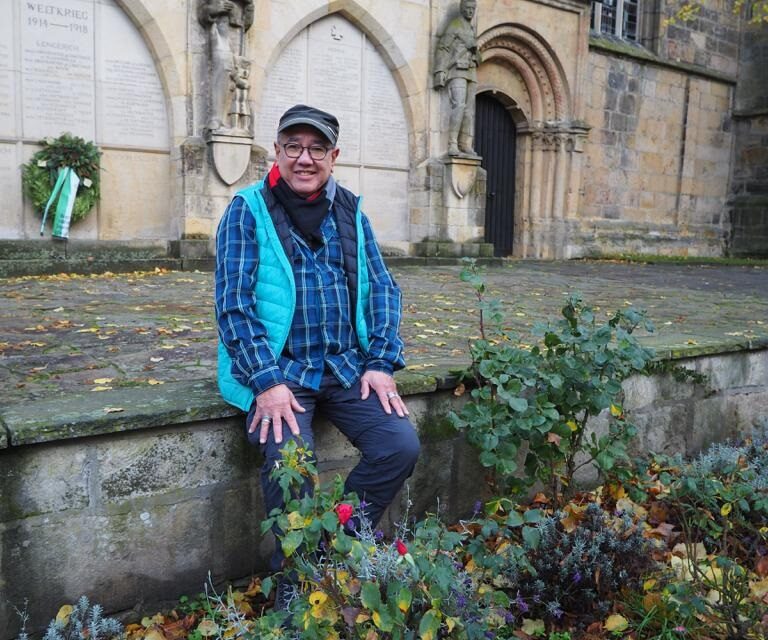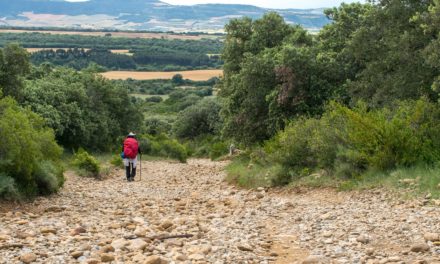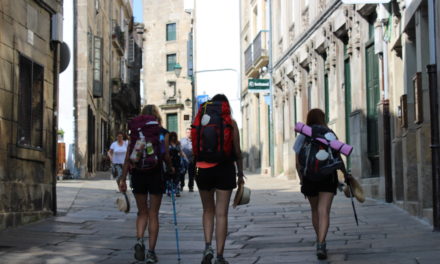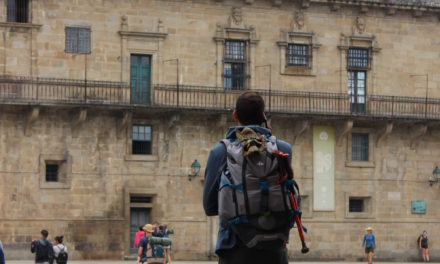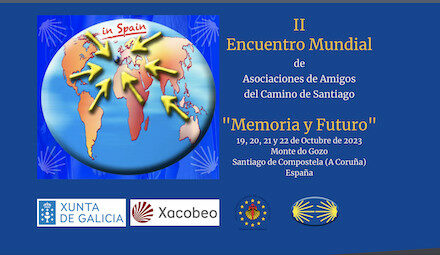Al andar se hace camino
y al volver la vista atrás,
se ve la senda, que nunca
se ha de volver a pisar,
Caminante no hay camino,
sino estelas en la mar.
Antonio Machado
Norman Sinclair was born in Venezuela, where he lived until he was 17 years old, but currently has German nationality. He arrived in Germany in 1968 with the idea of completing the biology studies that he had begun in Venezuela. He finally stayed in Germanyy, doing a doctorate in biology and training as an immunologist and allergist. After his recent retirement from the medical world, he decided to invest in a florist company in the German city of Lengerich, where he lives.
What interests us the most at the Jacobea Foundation is the fact that Norman Sinclair is an experienced pilgrim – between 2010 and 2015 he travelled almost 5,000 kilometers on foot – and that from his flower shop he has undertaken an extraordinary philanthropic action: the creation, donation and dissemination of “the Pilgrim Rose” along the Caminos de Santiago in Spain, Germany and other European countries.
– We always start with something of the order of personal history: How did you get to the Camino de Santiago?
I arrived on the Camino de Santiago because in 2009 a very close loved one died. I decided to do the Camino for that reason and I was finally able to do it in 2010, after a year of preparation. I travelled the Vía de la Plata, I wanted to arrive in Santiago on the 10th, the 10th of the 10th… and I got it! After eight weeks and four days, with the help of authorities and the police, who on some occasions had to open completely empty shelters for me.
From that first Camino I remember that in many towns they did not even ask me for the credential, they trusted me. Until Salamanca I didn’t really have the feeling of being on the Camino, because I walked basically alone. I also remember that I spent very hard weeks, walking under 35 or 36 degrees centigrade of heat. But my main memory is that of a very beautiful experience, which allowed me to get to know myself and other people who also offered me their help.
– And after that first Camino he did not stop…
Yes, the Vía de la Plata was followed by four other Caminos: the French Camino, the Portuguese Camino, the Primitive Camino and the Camino del Norte. I made them by dividing them into two sections or stages: one that I covered in summer and another in winter, always arriving in Santiago on December 24.
In winter there were always some difficulties, for example, when crossing O Cebreiro. Also on the Camino Norte I remember that the part that I covered in winter was very difficult, it was the section from Ribadeo and many hostels were closed. But the pilgrim’s will is great and he finally succeeds. If I didn’t have hot water to shower, I would resist two or three days until I found a pension, I didn’t care… I always wanted to arrive on December 24, because that was the date of death of the person whom I was commemorating when I began the Camino.
– And how does the pilgrim rose appear in this story?
It was not by chance, that rose was on the Camino, in a nursery in Valencia. The Ferrer family owns two important branches or nurseries specializing in roses: one of them is in Valencia and the other in Madrid. I found out about its existence through a botanical colleague and I did research to be able to bring roses to Germany, I looked for a way to reach the Ferrer family when I was going to retire as a doctor and had already bought a flower shop.
Flowers have always been in my life, they have to do with my personal history. I arrived in Europe at the age of 17 and with little more than 200 dollars in 1968. My mother was Spanish and my father was Filipino. I wanted to study in Europe and be independent. Things went well for me, largely because a convent opened its doors for me upon my arrival, I was able to study medicine and become a doctor, but to do so I also sold flowers in the market. In my years as a doctor, I always did volunteer work at that convent on weekends and, as I approached retirement, the idea of buying the flower shop came up, I bought it when it was bankrupt and I saved seven jobs, seven employees who today they work with me.
So, I became interested in roses, a very symbolic flower that men have cultivated for more than 4,000 years, and I went looking for one that captivated me. I looked for it in one of the two large nurseries belonging to the Ferrer family. We looked at the types of roses they had until I chose the one that today bears the name of peregrina: it has a lot of light, it shines, it is attractive and showy, it is very simple, it is very resistant, the size of its petals is very simple, it is a floribunda flower, a modern rose bush…
I made a large order of roses for my shop and, in addition, the Ferrers gave me two roses, but I couldn’t take them with me to Germany. I did make a large order of other interesting roses for my shop. Returning from Valencia, I stopped at a place where I used to stop in the past, a very Jacobean place: Turégano. And it was there that it all began, because I asked the parish priest to leave those roses that Mrs. Ferrer had given me, they were left there, in the church of Santiago, for Santiago Apóstol. Those were the first roses on the Camino, it happened about five years ago.
– And other roses arrived through his first order to Germany…
Those first roses were planted in Germany: I donated three of them to the city of Lengerich, where I live, next to a monument related to the Second World War. I chose to plant some roses there because The Path of Peace passes through Lengerich, it is a path reminiscent of the Peace Riders who exchanged messages between cities during the Thirty Years War, it was they who negotiated the peace agreement of 1645, in Lengerich became the conclusive for the peace of Westphalia.
But the Camino de Santiago also passes right in front of the door of my shop, because the Westphalian Way of Peace coincides with the Camino de Santiago on the Osnabrück-Lengerich-Münsterland-Cologne route. In the store we have stamps for the credentials of the pilgrims who pass in the direction of Cologne, we have our own one made by me and another from the state.
But things did not stop there… Throughout these years we have expanded the pilgrim rose project along the Camino de Santiago in Westphalia, on this route from the Camino de Santiago to Cologne, about 35-40 roses have already been planted.
– The pilgrim rose has also been multiplying its presence on the Camino de Santiago in Spain, it is beginning to be very popular among pilgrims and residents of many places on the Camino. Would you tell us more about your expansion along the Camino?
Yes of course. The rose had already been born with a name before I started my project, like the Castell d’Alaquás rose, after a castle on the outskirts of Valencia. But I soon began to sow it in various places on the itineraries of the Camino de Santiago, first in Turégano, but very soon on the Camino Frances.
The first rose that we planted on the Camino Frances was in O Cebreiro, next to the grave of Mr. Elías Valiña, it was a winter day… And that’s how it all began! The roses began to spread along this itinerary, definitively becoming pilgrims: Triacastela, Samos, Fonfría, Sarria, Paradela, Portomarín… Between O Cebreiro and Palas do Rei we planted around 100 roses. And there they continue, because the pilgrim rose is very resistant, if it is not stolen it does not need care.
Later I decided to go a little further and introduce it to Monte do Gozo and the city of Santiago de Compostela. First, we started at the entrance of Monte do Gozo, where we planted about 40 roses, emblematic, also four roses on the statue of Cándido Pazos. And then in the city of Santiago: in the convent of San Francisco and in the Mercedarian sisters. It was the first step of the rose in Santiago.
That was a first time, but currently the rose is also in the Pilgrim Reception Office, other places in Compostela and many more emblematic places on the French Way: Carrión de los Condes, Sahagún… With an important presence in the city of León, where the city council invited us to plant 12 roses in San Isidoro, Santa Ana, the Jewish Quarter Garden, the Carvajalas sisters, the San Francisco convent, San Marcos and the Castril bridge at the exit of León.
– But the project is to continue expanding the pilgrim rose beyond the Camino Frances, taking it to other itineraries of the Camino de Santiago…
Yes, we want to continue planting roses on the Camino del Norte and this year we have already planted around 20 roses on the Camino lebaniego, near San Toribio. But work also continues on other pilgrimage routes in Europe, such as the Via Künig, linked to the künig von Vach pilgrimage, which begins in Germany, as well as in other territories.
– And what plans do you have for the future regarding the pilgrim rose?
My philosophy of my life has always been to push yourself until you can say to yourself: it wasn’t easy, but I did it. Until now I have applied this same philosophy to the rose and I have been able to get on with the work, but now I am looking for people interested in the rose who continue with the work that has been started. For example, I seek the collaboration of the Jacobean Associations, the Associations of Friends of the Way can allow us to continue the project.
– Do you have any dreams pending fulfillment regarding the Camino or the pilgrim rose?
I think that with the encounter with the Hermann Künig a Compostela road from the city of León I have managed to conceive a very interesting project, since I was able to see and understand that there are abandoned towns, as well as some convents or monasteries in ruins, and the humility of places is in line with that of their churches. On this pilgrimage route I am trying to do something very particular with the Pilgrim Rose: the central purpose is to link the Camino de Santiago and the Monasteries. This idea is already being put into practice in Spain, where the Pilgrim Rose coexists in monastic residences such as San Zoilo de Carrión de los Condes, Samos Abbey, Monasteries of the Mercedarian Brothers, in Sarria, on the French Way.
I would not only like to spread this idea on the pilgrimage routes to Santiago de Compostela, but particularly in the most historically important monasteries in Spain and Europe. I also hope to put this idea into practice under the designation of planting the Pilgrim Rose in the Cistercian Monasteries that exist in Spain. In this line, one of the first will be the Oseira Monastery in Ourense in one of its main patios, the Patio de los Caballeros, like the Cistercian Monastery of Carrión, and in the province of León.
Before concluding this interview, I would like to express my gratitude to all the collaborators and friends who have participated in the beginning of this project called “Floral Way on the Camino de Santiago with the Pilgrim Rose”, in the route of some stages of the French Way, Camino del Norte in Spain, Camino Lebaniego as well as the Caminos de Santiago in Germany.
To my parents, in their earthly absence, I thank you for that spiritual support in accompanying me in this work that I have achieved in the path of life. Thank you.
……. No, it’s a stumbling block, it’s the truth of life, you are my Pilgrim Rose,
and there I will be waiting for you as my life passes on the other side of my eternity,
since you are and will always be my guide and companion.
You are my Pilgrim Rose on my Path of life.

